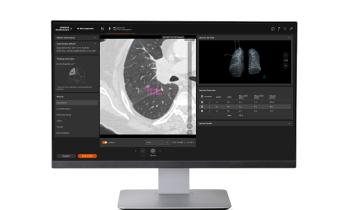Interview • Radiology in Europe
A German or Swiss paradise?
The current political framework changes healthcare structures and competitive dynamics for medical services providers. These issues were raised at the 11th Management and Strategy Congress MARA (Management in Radiology) in Bonn, in autumn 2015. Dr. Martin Maurer, one of the congress organisers, explained: ‘The objective of the MARA Congress is not to hold pretty lectures but primarily to address the current weak points in the field of radiology.’
Are challenges to radiology management comparable in these countries?

Generally, the challenges and management objectives in radiology are not country-specific and are similar in Germany and Switzerland. Demands are increasing everywhere, due to the growing subspecialisation, with very specific requirements and requests from referring doctors and the expectation of fast, high quality diagnoses – and this in the light of massively rising amounts of images. Radiologists also need additional time for activities such as participation in interdisciplinary tumour boards – and all this against a background of decreasing reimbursements.
Do financial aspects affect out-patient care?
From the service provider’s perspective, reimbursement for treatment of a statutory health insured patient in many cases only just covers the costs.
Dr. Martin Maurer
Unfortunately, these are increasingly coming to the fore in both countries. However, the conditions for radiologists are still a lot better in Switzerland. Although medical services there are also calculated on a point scale and evaluated and reimbursed according to time spent on a service and the average time to establish a diagnosis, Swiss radiologists in private practice still receive realistic compensation for services. This obviously leads to considerably higher reimbursements for all radiologists. In contrast, cost structures – for staff, cost of living and property are much higher.
Swiss patients receive invoices for all services provided. This creates transparency and an awareness of the value of individual medical services. German patients covered by statutory medical insurance do not have this awareness, which promotes an overuse of services.
‘Looking at conditions for radiologists in Germany you have to ask how the system is supposed to work in the long term. From the service provider’s perspective, reimbursement for treatment of a statutory health insured patient in many cases only just covers the costs. It may sound painful, but providing standard services for statutory health insured patients generates hardly any money for radiologists. From a health-political perspective the intention appears to be for the private medical insured to subsidise treatment for those with statutory insurance, significantly to keep the infrastructure of out-patient care going.
“Two-class” medicine is often quoted in this context. However, all German patients, regardless of their insurance cover, receive almost identical medical treatment, apart from some better comfort in hospital and quicker appointments. Therefore, it’s a rather a “two-class” system from the service providers’ perspective because identical services are reimbursed in different ways and radiologists in private practices are expected to simply accept this.
Germany’s problems result from too many statutory health insured patients making too small contributions in relation to their costs. This isn’t necessarily their fault: The overall level of income among the general public is too low for patients to make an appropriate contribution. In Switzerland the mean income is considerably higher and even an insured patient with a low income can still make a contribution that adequately covers costs.In Germany, I miss health politicians who make the general public honestly aware of these problems and finally will tackle structural problems that have been discussed for years.
What is the hospital situation?
Swiss hospitals have also introduced DRGs, but are still unaccustomed to them and they worry about their high own costs. As a German I’m more relaxed about it, especially as the Swiss DRG base rates are about three times those of Germany. However, there is still a tendency to increasingly consider radiology as a cost factor that should ideally be kept low, meaning that the significant benefit of radiology departments for hospitals is being ignored. German hospitals don’t appear to value this, especially looking at the reimbursement proportion for radiological services compared to overall DRG reimbursements: “basic” radiological services, such as a chest or abdominal CT scan, now receive extremely low reimbursements – a worrying situation where large parts of standard radiological examinations merely contribute towards breaking even. ‘Swiss hospitals primarily must deal with high costs, which has resulted in a “clear-out” process for smaller hospitals that cannot be run profitably. On the other hand, the Swiss public is emphatic about the provision of hospitals in remote locations, making it very difficult to close unprofitable facilities, from a political perspective.
Although many smaller hospitals also have high-quality radiological equipment e.g. CT and MRI scanners, they often don’t have radiologists on site overnight and at weekends for cost reasons, preferring to use the teleradiology services provided by Bern University Hospital.’
Which country offers the brightest future for radiologists?
I worry about the emergence of large practice networks with exclusively profit-oriented investors who buy up practices on a large scale.
Dr. Martin Maurer
It’s becoming increasingly risky and unattractive for German radiologists to invest their own capital in infrastructure of their own practice because the costs are particularly high. Incalculable political decisions, such as the often discussed abolition of private health insurance, would soon have existential implications for many private radiologists. Therefore, having their own practice is no longer attractive to younger radiologists. Existing practices are also investing less and less and a many older colleagues appear intent on just reaching retirement age. This promotes the development of larger networked practices to minimise risks and cut costs through economies of scale.
I worry about the emergence of large practice networks with exclusively profit-oriented investors who buy up practices on a large scale– with no obvious criticism from the National Association of Statutory Health Insurance Physicians. The lack of qualified young staff is a problem in both countries, because a large number of radiologists will retire in coming years. One positive situation is that many younger women – and men – see this profession as easy to combine with family.
It’s no use moaning about radiology’s prospects which I consider nonetheless being excellent. The need for radiological services will grow, as will a need for subspecialisation which will need comprehensive education and further training, whilst the cohesion as a profession must be maintained. We should focus on making patients and referring doctors aware of the importance of radiological services and continue to fight for adequate reimbursement.
Profile:
Dr. Martin Maurer is well placed to assess healthcare changes from the perspectives of two countries. The German radiologist, who worked at the Charité University Hospital in Berlin for several years, is now a Consultant at the Institute for Diagnostic, Interventional and Paediatric Radiology, at Bern University Hospital (Switzerland). He also has a degree in business administration and holds a Master in Health Business Administration. Along with clinical-radiological research Maurer has carried out numerous health-economic studies in radiology.
03.03.2016










